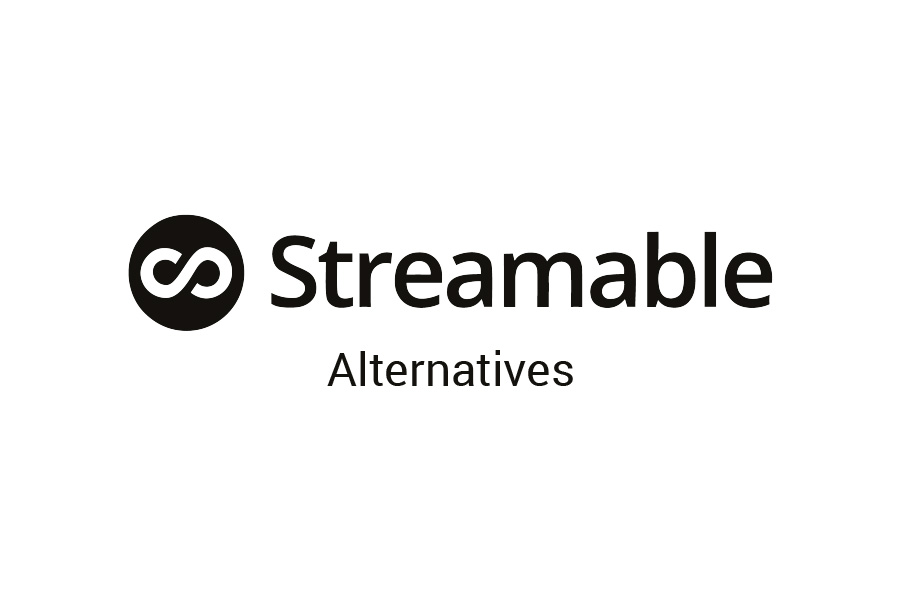In today’s digital era, video sharing platforms have become increasingly important for businesses, content creators, and consumers alike. Streamable is a popular platform that allows users to easily upload, share, and watch videos. However, there are numerous other platforms available, each with its own unique features and benefits. In this comprehensive guide, we will explore nine of the best Streamable alternatives, providing an overview of their features, benefits, limitations, and ideal use cases. We will also provide a handy comparison table and a list of frequently asked questions to help you make an informed decision.

1. YouTube
1.1. Overview
YouTube, the world’s most popular video sharing platform, has over 2 billion monthly active users. Launched in 2005, it has since become a go-to destination for video content, including music, gaming, education, and more.
1.2. Features and benefits
- Vast user base: Reach a massive audience.
- YouTube Studio: Monitor your channel’s performance and manage content.
- Monetization: Earn money through ads, channel memberships, and merchandise.
- Livestreaming: Engage with your audience in real-time.
1.3. Limitations
- Strict content policies: Videos may be removed or demonetized.
- Competition: Standing out can be challenging due to the platform’s popularity.
1.4. Ideal for
Content creators, businesses, and individuals seeking a large audience and monetization opportunities.
2. Vimeo
2.1. Overview
Vimeo, founded in 2004, is a video sharing platform that focuses on high-quality content, attracting creative professionals such as filmmakers, animators, and photographers.
2.2. Features and benefits
- High-quality video player: Enjoy better video quality than most competitors.
- No ads: A clean, ad-free viewing experience.
- Collaboration tools: Easily work with team members on video projects.
- Privacy settings: Control who sees your videos.
2.3. Limitations
- Limited free plan: Storage and features are restricted.
- Smaller audience: Less traffic compared to YouTube.
2.4. Ideal for
Creative professionals and businesses looking for a high-quality, ad-free platform to showcase their work.
3. Dailymotion
3.1. Overview
Dailymotion, established in 2005, is a global video sharing platform with a strong presence in Europe. It offers a wide range of content, including news, sports, entertainment, and more.
3.2. Features and benefits
- Large audience: Over 300 million monthly users.
- Monetization: Earn revenue through ads and pay-per-view options.
- Video quality: Supports up to 4K resolution.
- Customizable player: Personalize the look and feel of your video player.
3.3. Limitations
- Less popular than YouTube: Smaller overall user base.
- Content restrictions: Certain content may be prohibited or limited.
3.4. Ideal for
Content creators and businesses seeking a less crowded alternative to YouTube with monetization options.
4. Wistia
4.1. Overview
Wistia, founded in 2006, is a video hosting platform designed specifically for businesses. It offers powerful analytics and marketing tools to help businesses grow.
4.2. Features and benefits
- Video analytics: Gain insights into viewer engagement and behavior.
- Lead generation: Capture leads with customizable video CTAs and forms.
- Custom branding: Add your logo and choose your player’s colors.
4.3. Limitations
- No free plan: Only a limited free trial is available.
- Not a community platform: Lacks the social features of platforms like YouTube and Vimeo.
4.4. Ideal for
Businesses seeking a professional video hosting solution with advanced analytics and marketing tools.
5. Vidyard
5.1. Overview
Vidyard, established in 2010, is a video hosting and analytics platform aimed at helping businesses improve their video marketing efforts.
5.2. Features and benefits
- Video analytics: Understand viewer engagement and measure ROI.
- Personalized video: Tailor video content to individual viewers.
- Integrations: Connect with popular marketing and sales tools, such as HubSpot and Salesforce.
- Customizable player: Match your brand’s look and feel.
5.3. Limitations
- Limited free plan: Access to advanced features requires a paid subscription.
- Primarily business-focused: Less suitable for casual content creators.
5.4. Ideal for
Businesses looking to enhance their video marketing strategies and gain valuable insights into viewer behavior.
6. JW Player
6.1. Overview
JW Player, launched in 2005, is a customizable video player and platform that caters to both individual content creators and businesses.
6.2. Features and benefits
- Customizable player: Modify the appearance and functionality of your video player.
- Monetization: Generate revenue through ads and subscriptions.
- Analytics: Track viewer engagement and content performance.
- Livestreaming: Broadcast live events to your audience.
6.3. Limitations
- No free plan: Only a limited free trial is available.
- Less user-friendly: Customization options may require some technical knowledge.
6.4. Ideal for
Content creators and businesses seeking a highly customizable video player with monetization and livestreaming capabilities.
7. SproutVideo
7.1. Overview
SproutVideo, founded in 2010, is a video hosting platform designed for businesses, offering robust security, analytics, and marketing tools.
7.2. Features and benefits
- Advanced security: Protect your videos with password protection, IP restrictions, and more.
- Video analytics: Analyze viewer engagement and content performance.
- Marketing tools: Create customizable video landing pages and calls to action.
- API and integrations: Connect with popular marketing, CRM, and analytics platforms.
7.3. Limitations
- No free plan: Only a limited free trial is available.
- Not ideal for casual users: Geared towards businesses and professionals.
7.4. Ideal for
Businesses seeking a secure and feature-rich video hosting solution with advanced marketing capabilities.
8. Brightcove
8.1. Overview
Brightcove, established in 2004, is a leading enterprise video hosting and marketing platform, offering a wide range of features and tools for businesses.
8.2. Features and benefits
- Scalable hosting: Reliable video delivery for large-scale enterprises.
- Advanced analytics: Gain insights into viewer behavior and content performance.
- Monetization: Generate revenue through ads, paywalls, and subscriptions.
- Livestreaming: Broadcast live events and webinars.
8.3. Limitations
- No free plan: Pricing tailored to enterprise customers.
- Complex interface: Steeper learning curve compared to other platforms.
8.4. Ideal for
Large businesses and enterprises seeking a comprehensive video hosting and marketing solution.
9. Kaltura
9.1. Overview
Kaltura, launched in 2006, is an open-source video platform catering to various sectors, including education, media, and enterprises. It provides a flexible and scalable solution for managing and delivering video content.
9.2. Features and benefits
- Open-source: Customize and extend the platform to meet your unique needs.
- Scalable: Supports large-scale video hosting and delivery.
- Video management: Organize, edit, and publish videos with ease.
- Integrations: Connect with various third-party tools and platforms.
9.3. Limitations
- No free plan: Pricing is tailored to specific sectors and needs.
- Requires technical expertise: Open-source nature may necessitate developer support.
9.4. Ideal for
Organizations and businesses seeking a flexible, open-source video platform that can be tailored to their unique requirements.
Comparison Table
| Platform | Key Features | Pricing |
|---|---|---|
| YouTube | Large audience, monetization, livestreaming | Free |
| Vimeo | High-quality video player, ad-free, collaboration tools | Free and paid plans |
| Dailymotion | Monetization, customizable player | Free |
| Wistia | Video analytics, lead generation, custom branding | Paid plans |
| Vidyard | Video analytics, personalized video, integrations | Free and paid plans |
| JW Player | Customizable player, monetization, livestreaming | Paid plans |
| SproutVideo | Advanced security, video analytics, marketing tools | Paid plans |
| Brightcove | Scalable hosting, advanced analytics, monetization, livestreaming | Custom pricing |
| Kaltura | Open-source, scalable, video management, integrations | Custom pricing |
Conclusion
In this guide, we have explored nine of the best Streamable alternatives, each with its own unique features, benefits, and limitations. When choosing the right platform for your needs, consider factors such as your target audience, video quality requirements, monetization options, and your budget. By selecting a platform that aligns with your goals, you can effectively engage your viewers and maximize the impact of your video content.
Frequently Asked Questions
- Which Streamable alternative is best for small businesses? Wistia and Vidyard are excellent options for small businesses, as they offer robust analytics and marketing tools to help grow your business. For those on a budget, YouTube and Vimeo are also good choices, with free plans and large user bases.
- How do these alternatives compare in terms of pricing? YouTube, Vimeo, and Dailymotion offer free plans, while Wistia, Vidyard, JW Player, and SproutVideo provide paid plans with varying features. Brightcove and Kaltura offer custom pricing tailored to the needs of large businesses and enterprises.
- Can I use multiple video sharing platforms simultaneously? Yes, you can use multiple platforms to reach a wider audience and leverage the unique benefits of each platform. However, managing multiple platforms can be time-consuming, so consider focusing on the platforms that align best with your goals.
- Which platform offers the best video quality and streaming experience? Vimeo is known for its high-quality video player and ad-free viewing experience. Brightcove and Kaltura also offer reliable, high-quality video hosting and streaming for large-scale businesses and organizations.
- What are some factors to consider when choosing a video sharing platform? When selecting a video sharing platform, consider your target audience, desired video quality, monetization options, available features, and budget. By assessing these factors, you can choose the platform that best meets your needs and maximizes the impact of your video content. Additionally, consider the ease of use, available integrations, and the potential need for technical support when making your decision.
- How important are analytics when choosing a video sharing platform? Analytics play a crucial role in understanding viewer behavior, measuring the success of your content, and optimizing your video marketing strategies. Platforms like Wistia, Vidyard, and Brightcove offer advanced analytics features that can provide valuable insights into your audience’s engagement and preferences.
- Do all video sharing platforms offer monetization options? Not all platforms provide monetization options. YouTube, Dailymotion, and JW Player offer monetization through ads and other methods, while Vimeo, Wistia, and Vidyard primarily focus on professional and business use cases. When considering a platform, be sure to research their monetization options to ensure they align with your goals.
- Which platform is best for collaboration and team management? Vimeo and Wistia both offer collaboration tools that allow team members to work together on video projects. Vimeo’s collaboration features include team accounts, review pages, and version history, while Wistia offers project management tools, password-protected video sharing, and the ability to add collaborators with specific permissions.
- What security features should I look for when choosing a video sharing platform? When selecting a platform, consider features such as password protection, IP restrictions, domain-level privacy, and encryption. Platforms like SproutVideo and Brightcove offer advanced security options to protect your videos and control access. Additionally, consider the platform’s privacy policy and data handling practices to ensure compliance with relevant regulations.
- Do these alternatives support livestreaming? Some of the Streamable alternatives support livestreaming, including YouTube, JW Player, and Brightcove. Livestreaming can help you engage with your audience in real-time and broadcast live events, webinars, or product launches. Before choosing a platform, check their livestreaming capabilities to ensure they meet your requirements.
